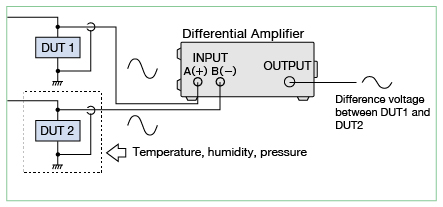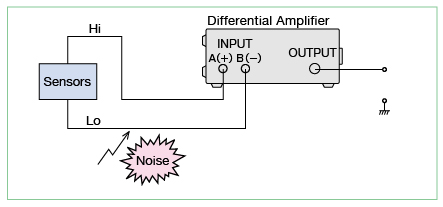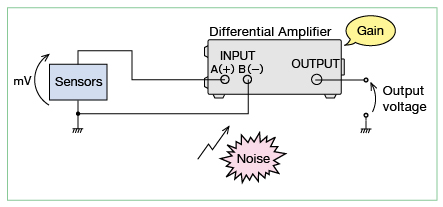

|
Measurement of minute
changes in devices
(semiconductors)
due to
the surrounding
environment
|

|
|
|

|
|
The differential amplifier 5307 outputs a signal obtained
by amplifying A minus B, which is the difference between
the signals of input A and input B.
The same signal is applied to two semiconductor devices
of the same performance, and the output signal is input
to A and B of the differential amplifier.
Then, by changing the ambient environment (temperature,
humidity, pressure) of one device, only the change due
to the influence can be amplified and output.
|
For example, if the device voltage is 1V and the effect of
the change is 1mV, the A input will be 1V + 1mV, the B input
will be 1V, and the output will be the voltage obtained by
multiplying 1mV of A minus B by the gain.
Without a differential amplifier, the gain cannot be
increased because the 1V + 1mV signal must be
amplified.
With a differential amplifier, any minute difference between
A and B can be amplified with a large gain, making
measurement easy.
|

|

|
Reduce the effects of
external noise
|

|
|
|

|

|

|
Prevent the effects of noise through the sensor
cable
|
| |
A differential amplifier can be used in the sensor signal
to reduce external noise.
If the output cable from the sensor contains inductive
noise, connect the sensor Hi and Lo to the differential
amplifier inputs A and B.
Since the differential amplifier is not affected by the
common-mode noise, the output signal of the sensor can
be amplified without being affected by the inductive
noise.
|

|

|

|
Prevent the effects of noise passing through the
ground
|
| |
When one side of the sensor is grounded, you typically
use an amplifier with a single-ended
configuration.
However, if there is noise in the ground, a potential
difference will occur between the sensor ground and the
amplifier ground.
In such cases, use a differential amplifier to connect
the sensor ground to the amplifier's B input.
The sensor signal can be amplified without being
affected by the potential difference in the ground.
|
| |
For example, in 100 times amplification of a voltage of 1
mV, if there is a potential difference of 10 µV
between the grounds due to noise, the output of the
amplifier will be 101 mV.
By connecting the ground signal of the sensor to the B input
of the differential amplifier, only the potential difference
between A and B is amplified.
Therefore, the output of the amplifier is not affected by
the 10 µV noise, which is the potential difference
between the grounds.
|

|

|

|
|
|
|
|